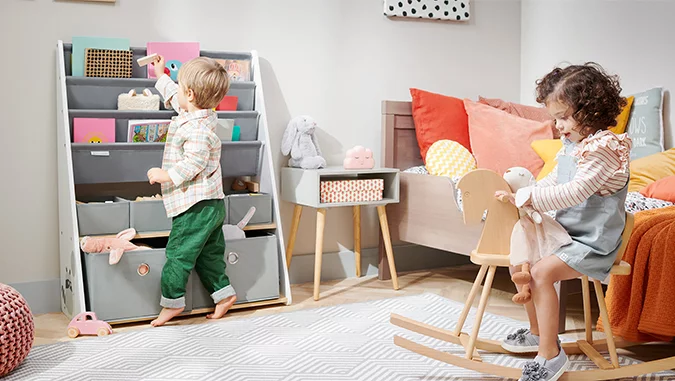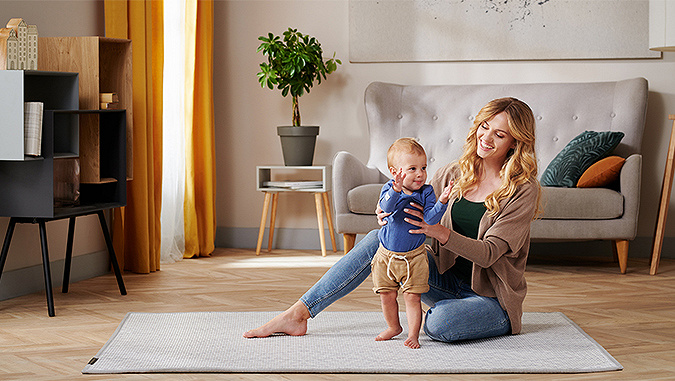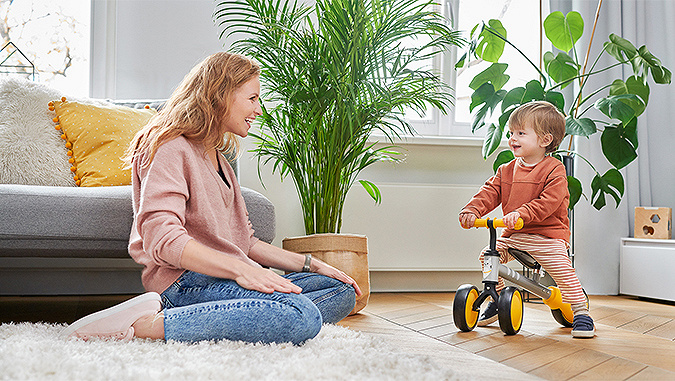Ride-on toys for babies and toddlers - what are they and whether you should use them
7 min

A baby's first step is one of those moments that you remember forever. That is why it is so eagerly awaited. Some parents wait longer than others, because the development of walking is an individual matter. However, you can support this process by encouraging your child to try his/her best. A ride on will be helpful here, supporting the process of learning to walk. It gives the child confidence, courage and helps to maintain stability.
What is a ride on?
A baby ride on is a kind of device which is intended to provide a baby with a sense of balance while taking their first steps. It can be a wheeled toy that your baby holds in front of them while walking. Do not confuse a ride on with a walker, which restricts your baby's movements and forces them to walk continuously. A ride on is a free-standing device that your child can reach for at any time to walk confidently.

When can a child use a ride on?
There is no established age that is right for a child to start using a ride on. Everything depends on the development of your child. The rule is that a baby should be able to pull itself up and stand on its own, and in addition to that, it should be able to make a step or two on its own, so it should have a sufficiently developed spine. And this can happen at different ages. Acquiring the ability to walk is a process that develops over time. Some children start walking on their first birthday, and some only a year later. There is no rule. Therefore, you should observe your child and only offer them some aid to keep balance in the form of a ride-on when it is safe for them to do so. In case of any doubts, it is best to consult a physiotherapist, especially if you are concerned about your child's motor development, for example, they still do not crawl. Otherwise, the toddler may acquire pelvic anteversion and lumbar lordosis, because the center of gravity of their body will be shifted forward.
Types of ride-on toys
In principle, you can divide baby ride-on toys into two types - traditional, that is, those that the toddler pushes in front of them, and those on which the child can sit down and ride, pushing their feet against the floor. Both types have an almost unlimited number of variants. Because ride-on toys are also toys with different shapes and functions. They can be at the same time sorting toys, containers for blocks, kitchen, workshop with tools, lawnmower, locomotive, car, animal or piano. It is a very good idea for a baby ride-on to have additional use, because its primary function can quickly become boring for a toddler getting used to walking, and the kitchen or workshop will entertain them for much longer.
Wooden or plastic ride-on?
Pushchairs for children can also be divided according to the material from which they are made. In this way, we distinguish two types: wooden and plastic. Which of them are better? Everything is obviously a matter of individual preference, but it is possible to point out the good and bad sides of each of these models.
Plastic ride-on toys
Plastic ride-on toys have many more options. They usually become multifunctional, interactive devices. They can light up, play, make sounds, that is, do everything that interactive toys do. Then the function of a baby ride-on is really only one of many. The disadvantage of plastic ride-on toys is that they are sometimes more wobbly than wooden ones - because of the weight. They are simply lighter and sometimes you need to put extra weight on them to make them perform their original function.
Wooden ride-on toys
You're unlikely to encounter this problem with wooden ride-on toys, which are heavier and therefore more stable and slower, meaning safer. These models, for obvious reasons, will not play or flash, but that doesn't mean they don't offer anything besides the pushing function. They can be kitchens, workshops or sorters with an educational panel full of buttons, knobs, cogs and gears. Supporters of natural toys will probably find that they are also more aesthetic and blend in better with the minimalist interiors of children's rooms.
Disadvantages of baby ride-on toys
There are many opponents of baby ride-on toys, who believe that their use can cause more harm than good. First of all, experts say that it can cause postural defects in children - especially if a child starts using it too early or its wheels slip on the ground. Such a ride-on may aggravate pelvic anteversion and lumbar lordosis. A child chasing a ride-on does not activate the abdominal and gluteal muscles, but overloads the muscles of the lower spine.
Lack of proper adjustment of the wheels can also be dangerous for another reason. A child may simply not be able to keep up with the toy, which will probably end sooner or later with a fall. A ride-on that is too light, which will not provide stable support, poses a similar threat. Walking with a ride-on is therefore a challenge especially for parents who cannot let their child out of their sight in such a situation.
Advantages of ride-on toys
So, do ride-on toys for children have any advantages? As a matter of fact, they do. The first is obvious - with a heavy and stable ride-on, the child receives solid support that can encourage them to walk, and thanks to this, the little one will strengthen their legs and slowly dare to finally set off on their first independent walk. What's more, the device can support proper posture, because a child in this situation reflexively tenses the right parts of the muscles.
It is also pointed out that ride-on toys are superior to baby walkers, which are explicitly criticized for interfering with learning to walk. Aride-on does not restrict a child, because it is not put into it. It is used by a child only when it feels the need to do so. It also works well as an attractive toy full of mirrors, beads, gears and colorful buttons.

What to look for when choosing a ride-on?
When choosing a ride-on for your child, first pay attention to its safety. Several factors will guarantee it. First of all, the weight. It should be neither too heavy, as a toddler may not be able to handle it, nor too light, as it will be unstable and thus wobbling. Secondly - traction. Wheels shouldn't slip, because a child won't be able to keep up with him. Rubber wheels are the best choice, moreover they are much quieter than plastic or wooden ones and they do not scratch the floor. Thirdly, the shape. A baby ride-on should be free of any sharp elements; choose one with rounded corners. Fourth - certificates. Pay attention to the certificates and do not buy one that will not have them at all.
Once you have chosen a safe ride-on, look at other elements, such as durability, adjustability and accessories. In the market you will find baby ride-on toys from different manufacturers, not all of them care about the quality of raw materials and workmanship. And this affects both the safety and longevity of the equipment. Some models offer handle and wheel speed adjustment - so you can adjust these parameters to the child's conditions and level of development. Do not forget that the pusher is also a great toy, so consider the additional functions, shape and opportunities to stimulate child development with an interactive toy.
Valuable and healthier alternatives to ride-on toys
Baby ride-on toys have as many supporters as opponents. The latter claim that in the process of learning to walk it is much better to bet on other forms of support - for example, those on which the child can sit down and ride, pushing their feet against the floor. The reason is that they do not strain the spine, do not cause posture defects, and exercise the sense of balance, motor coordination and leg muscles.
It stimulates a child's deep sensibility and also encourages a little one more. More advanced toys - a bike with side wheels for children who can't walk on their own yet. Another advantage of bicycles is that they can often be very easily transformed into two-wheelers - adapted for children who already maintain their balance independently.
An original and healthy form of a bicycle is our tricycle balance bike CUTIE, thanks to which the child exercises balance and, at the same time, develops motor skills necessary for riding a bike. CUTIE has all the advantages of a bicycle - it does not strain the spine and supports correct posture. Moreover, it can be an important step towards motor development of a child. We also have a rocking horse with the function of a ride-on in Kinderkraft, which will both entertain the child and help in learning walking skills. It is a 2 in 1 equipment, which provides the toddler with a lot of fun while rocking, but in one moment it can turn into a ride-on, developing coordination and strengthening legs.
